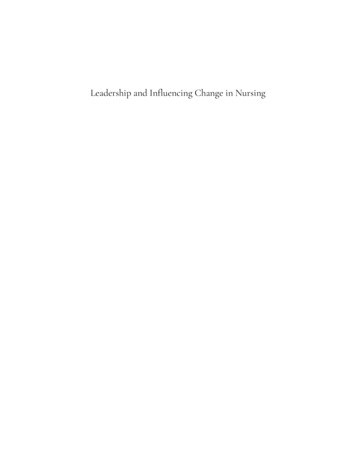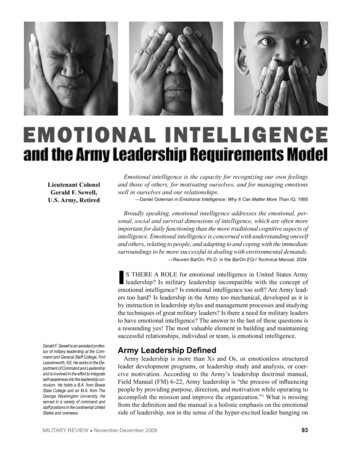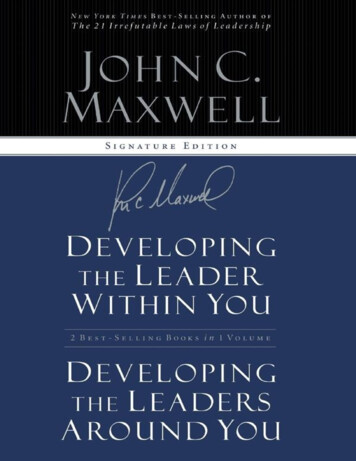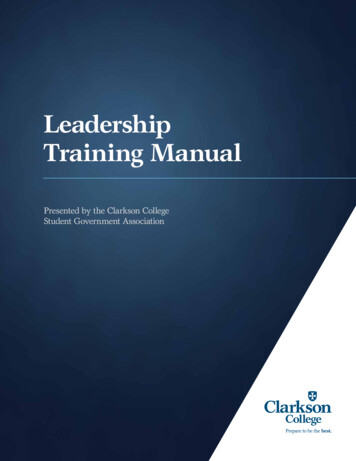
Transcription
Leadership and Influencing Change in Nursing
Leadership and Influencing Change inNursingJOAN WAGNERAMANDA WILLCOX, YVONNE HARRIS, WENDYWHITEBEAR, SUSAN BAZYLEWSKI, STACY MULLER, SONIAUDOD, SHAUNA DAVIES, NORMA RABBITSKIN, MAURAMACPHEE, LOUISE RACINE, LISA LITTLE, JOAN WAGNER,COLLEEN TOYE, BRENDALYNN ENS, BEVERLY BALASKI,ANTHONY DE PADUA, ANNE SUTHERLAND BOAL, ANDJUDY BOYCHUK DUCHSCHERUNIVERSITY OF REGINA PRESSREGINA
Leadership and Influencing Change in Nursing by Joan Wagner is licensed under a Creative Commons Attribution 4.0International License, except where otherwise noted.The Creative Commons license permits you to retain, reuse, copy, redistribute, and revise this book — inwhole or in part — for free providing the author is attributed as follows:Leadership and Influencing Change in Nursing edited and co-authored by Joan Wagner, and published byUniversity of Regina Press (2018), is licensed under a CC BY 4.0 International License.If you redistribute all or part of this book, you must include on every digital page (including but not limitedto EPUB, PDF, and HTML) and as part of the copyright notice of a printed copy the following:Download this book for free at www.uregina.ca/open-access/open-textbooks.License exceptions:Chapter 3 section 2 “Living within the Community”, as told by Norma Rabbitskin of Big River First Nation, isbased on the Traditional Knowledge of the Big River First Nation and is not licensed under the CreativeCommons Attribution 4.0 International License. Please respect the Protocol of Indigenous TraditionalKnowledge translation and contact Norma Rabbitskin at the Sturgeon Lake Health Centre if you wish to usethis content further.Figure 4.1.1 [May 1897] “Countess of Aberdeen in Queen’s U Robes Topley,” by William James Topley(1845-1930), photo courtesy of Library and Archives Canada under the reproduction reference numberPA-027869 and under the MIKAN ID number 3194681, is released in the Public Domain, via WikimediaCommons.Figure 4.1.2 [1889], photo courtesy of the Provincial Archives of Saskatchewan, Photographic ServicesCollection, collection number R-B10796, is released in the Public Domain.Figure 10.5.1 [January 1958], photo courtesy of the Provincial Archives of Saskatchewan, PhotographicServices Branch Collection, collection number R-B6805, is used with permission. All rights reserved.Figure 13.1 “Photograph by Jocelyn Augustino taken on 08/30/2005 in Louisiana” by Jocelyn Augustino,FEMA / FEMA Photo Library is released in the Public Domain, via Wikimedia Commons.Figure 13.1.1 “Landscape view of wildfire near Highway 63 in South Fort McMurray,” by DarrenRD, is licensedunder a CC BY-SA 4.0 International License, via Wikimedia Commons.Figure 13.3.1 “Mercy conducts mass casualty exercise during Pacific Partnership 2015 [Image 12 of 12]”, byMayra Conde, identified by DVIDS, is released in the Public Domain, via Wikimedia Commons.
The following three figures in Chapter 16 “Emerging Nursing Leadership Issues” are used with thepermission of the creator Judy Boychuk Duchscher and are not covered by the Creative Commons Licenseused in this textbook.Figure 16.7.1 “Quality Workplace Factors for New Nursing Graduates” is 2012 Judy Boychuk Duchscher. Allrights reserved, used with permission.Figure 16.7.2 “Transition Stages Model” is 2007 Judy Boychuk Duchscher. All rights reserved, used withpermission.Figure 16.7.3 “Transition Shock Model” is 2007 Judy Boychuk Duchscher. All rights reserved, used withpermission.For questions regarding the licenses and publication, please contact uofrpress@uregina.ca. To learn moreabout University of Regina Press’s Open Textbook Publishing Program, visit www.uofrpress.ca.Cover design: John van der Woude, JVDW Designs, is licensed under a CC BY 4.0 International License.Cover image: “Doctor Nursing Hospital Nurse Bless You Medicine” available from Max Pixels is licensed CC0Public Domain.This textbook can be referenced. For example, in APA citation style, it would appear as follows:Wagner, J. (Ed.). (2018). Leadership and Influencing Change in Nursing. Regina, SK: URPress. Retrieved .
ContentsAbout the Book1Joan WagnerForewordviiImproving Health Outcomes of Indigenous PeopleWendy Whitebear1.Identifying Your Leadership Strengths and Opportunities for Growth9Joan Wagner2.Diversity in Health Care Organizations25Sonia Udod and Louise Racine3.Working with Indigenous Leadership and Indigenous Environments52Anthony de Padua and Norma Rabbitskin4.The Role of Nurse Leaders in the Development of the Canadian Health73Care SystemJoan Wagner5.Providing Nursing Leadership within the Health Care System92Joan Wagner6.Primary Health Care105Interprofessional Leadership, Collaboration, and TeamworkColleen Toye and Joan Wagner7.Leadership in Quality Management and Safety129Joan Wagner8.Leaders and Evidence-Informed Decision Making143Maura MacPhee9.Common Change Theories and Application to Different Nursing155SituationsSonia Udod and Joan Wagner10.Using Advocacy to Galvanize Ethics into ActionJoan Wagner174
11.Identifying and Understanding How to Manage Conflict196Dispute Resolution Office, Ministry of Justice (Government ofSaskatchewan)12.Responsibility and Authority of Nurse Leaders216Lisa Little, Joan Wagner, and Anne Sutherland Boal13.Emergency Preparedness and Response232Yvonne Harris14.Nursing Leadership through Informatics249Facilitating and Empowering Health Using Digital TechnologyShauna Davies15.Regulation, the Law, Labour Relations, and Negotiations261Beverly Balaski16.Emerging Nursing Leadership Issues283Brendalynn Ens, Susan Bazylewski, and Judy Boychuk DuchscherAbout the Contributors314Acknowledgements322Open Access Publishing323Library and Archives Canada Cataloguing in Publication324
About the BookJOAN WAGNERLeadership and Influencing Change in Nursing is designed for a single-semester introduction tothe professional nurse’s leadership role as both a care provider and a formal leader. Nursing students will take this course in their third year as they prepare to assume a professional nursingrole within the clinical health care environment. An assortment of authors with diverse nursing leadership roles across Saskatchewan and Canada have contributed to this textbook. Thesediverse voices are focused on providing student nurses with the foundational tools, techniques,and knowledge required to empower them to meet the leadership challenges found within theever-changing Canadian health care environment. Assembling this information using an onlineformat allows for the material to be updated regularly so as to keep pace with the rapid expansion of knowledge.The specific goals of this textbook are: to ensure the information is relevant to Saskatchewan nursing students, to tailor the content to nursing students’ needs for both practical knowledge and theoretical knowledge, to provide up-to-date, evidence-informed content on nursing leadership, to thread Indigenous content throughout the textbook, and to tailor the textbook to the curriculum.APPROACH AND PEDAGOGYThis open access textbook introduces you to concepts related to leadership and the ability toinfluence change in the nursing profession. Essential theory and readings will be provided. Theauthors offer real-life management wisdom that is derived from a combination of clinical practice and evidence-based knowledge obtained through research. This wisdom will assist you indeveloping essential critical thinking skills that will enable you to make critical leadership decisions based on evidence-informed best practice. The authors will continue to work to ensurethat the readings provided in this textbook contain the most up-to-date and relevant information. Since this is an open textbook, content will be reviewed and updated annually to ensurethat the predetermined critical learning elements and outcomes are met for the course in whichit is used. Instructors may assign additional readings in their classes in order to enrich yourlearning.1
Each chapter begins with a significant leadership quotation relevant to the chapter content. Keyterms throughout the chapters are highlighted in bold.Coloured boxes are used in each chapter to differentiate and highlight important learning features (see diagram below).Key Learning FeaturesLearning ObjectivesFrom the FieldResearch NotesEssential Learning ActivitiesExercisesThe Learning Objectives set out at the beginning of each chapter provide a guide to chaptercontents and structure to your learning.Three types of textboxes in each chapter offer important information:From the Field textboxes provide wise words from nurse leaders.Research Notes demonstrate how each chapter is evidence-based and provide you with links toimportant academic research that further explores the critical topics addressed in each chapter.Essential Learning Activities in each chapter include links to important resources. TheseEssential Learning Activities may also include podcasts from chapter authors that have beendeveloped for this textbook. The authors have chosen to provide you with links to sourcedocuments and videos, rather than summarizing or restating the contents of these importantresources. These Essential Learning Activities are an integral part of the chapter content and willprovide you with an in-depth understanding of contemporary issues within the nursing profes-About the Book 2
sion. It is important to review the sources offered in Essential Learning Activities and completethe accompanying questions. These questions require you to apply critical thinking and synthesize new knowledge. The information within these links is an essential component of your coursework. This important information will not be provided elsewhere within the textbook.Each chapter ends with a Summary, which gives a general overview of chapter content and areview of the chapter objectives, a number of Exercises to give you an opportunity to review anduse your new leadership knowledge, and a complete list of References for all material cited inthe chapter to assist you in locating it as needed.HYPOTHESISHypothesis (or Hypothes.is) is an open source web annotation tool that students and instructorscan use to highlight and annotate online text, which they can share publicly or privately (forgroup discussion) or use for individual study. Hypothesis encourages deeper engagement withacademic text and other Internet resources.Hypothesis has been enabled for the online format of this textbook. In order to use this tool,you will first need to create a free account with Hypothesis and then follow the step-by-stepinstructions.For more information, Hypothesis offers the following Quick Start Guides:1. Quick Start Guide for Students2. Quick Start Guide for TeachersCHAPTER STRUCTUREChapter 1 introduces the emerging nurse leader to leadership theory. Descriptions of the skillsthat form the core of leadership excellence are provided. In addition, a quick overview of different nursing leadership styles that have been practised over the past century is presented.Emerging nurse leaders are also given the opportunity to compare and contrast different leadership styles while building a foundation for their own leadership style.Chapter 2 provides a comprehensive discussion of workplace diversity in health care organizations. The nurse leader is introduced to cultural diversity and theoretical models that provideguidance to nurses in their provision of culturally competent care. Nurse leaders are assisted indeveloping an understanding of diversity, which will help them, as nurse leaders, to manage theworkplace.3 About the Book
Chapter 3 offers an introduction to Indigenous health care and supports nurse leaders “tobecome leaders in the ‘Indian way’ ” (Nichols, 2004, p.177). The nurse leader is provided with asnapshot of the Indigenous worldview and the authors illustrate how worldviews affect leadership decisions. A review of the evolution of the health care system in Indigenous communitiesand the development of Indigenous health care structures provides the student with furtheressential knowledge required for nursing leadership. This chapter concludes with recommendations that will support the nurse leader in future collaborative work with Indigenous communities.Chapter 4 illustrates the historical connections between the nursing profession and the Canadian health care system. Historically, the role played by nurses ranged from providing care toearly settlers and Indigenous peoples, to lobbying for extensive changes to the Canada HealthAct, to establishing PhD nursing programs, and finally, developing a unique body of Canadiannursing research. Nurse leaders have been a strong and vigilant group dedicated to building thefuture for nursing and health care in Canada.Chapter 5 highlights some of the significant changes occurring within the Canadian health caresystem that have had an impact on nursing leadership and nursing practices. It contains a briefoverview of the principles of a complex adaptive system and the importance of an organization’svision, mission, and values in providing guidance to nurse leaders for decision making. The chapter concludes with a discussion of the recent adaptations to our health care organizational culture, which have led to an evolving scope of practice for registered nurses and the creation of aprotocol for delegation of care.Chapter 6 stresses the need for collaboration between health professionals to provide qualityhealth care to clients in the community. The shift to care in the community sector is challengedby the specialized care of a growing population of geriatric clients, with a distinct focus onIndigenous seniors, and the special attention required by people with mental health and palliative care needs. Strong nurse leaders are required to engage in interprofessional collaborativerelationships that lead to effective teamwork focused on determining client needs and ensuringsuccessful outcomes.Chapter 7 focuses on the development of quality management initiatives throughout the worldin response to emerging patient safety issues. The impact of Magnet hospitals in the UnitedStates and the Francis report in England on international patient safety culture will be describedin this chapter. Finally, the ways in which quality care is affected by Lean management principlesand quality improvement tools, such as the plan-do-study-act cycle, will be discussed.About the Book 4
Chapter 8 illustrates the importance of evidence-informed leadership and practice for the delivery of safe, quality patient care. The three clusters of innovation addressed by leaders to promote a transparent learning organization are reviewed in this chapter. Leaders must constantlyquestion, listen, and explore better ways for delivering quality and safe care that it is basedon evidence. The chapter concludes by describing the opioid crisis in Canada and the US anddemonstrating how evidence-informed harm reduction approaches bring nurse leaders back tobasic nursing principles.Chapter 9 stresses the importance of nurse leaders as change agents. Different theories andmodels of change theories are presented and several theories are applied to the nurse leader’srole in managing change. The chapter concludes with a discussion of resistance to change, withpractical suggestions that will assist the leader in walking beside individuals throughout change.Chapter 10 introduces the Canadian Nurses Association’s (CNA) Code of Ethics, which guidesCanadian nursing practice. With its focus on “how broad societal issues affect health and wellbeing,” the Code of Ethics calls for advocacy to address health inequities. A discussion of advocacy, social justice, power, empowerment, critical social theory, whistle-blowing, and socialactivism provide the student with a foundation to better understand the requirements for nurseleaders to advocate for the health and well-being of all, as described in the Code of Ethics.Chapter 11 shares the wisdom of mediators from the Ministry of Justice’s Dispute ResolutionOffice, and other experts, on how to resolve conflict. This chapter starts with a description ofconflict and provides different approaches to dealing with it. These approaches are then appliedto real-life nursing scenarios. A description of how conflict escalates and advice on how to deescalate conflict and coach people toward resolution concludes the chapter. This knowledgewill assist nurse leaders in learning to understand others and adapt their leadership approachesaccordingly.Chapter 12 focuses on the tools and resources required to support the nurse leader and buildson ethical and professional nursing practices. The recent transformation of the Canadian healthcare system requires the nurse leader to be visionary and contemporary while demonstratingstrong organizational and management skills. The authors discuss changes in the system thatrequire the nurse leader to align personal and professional values, such as those found in theCNA Code of Ethics, with responsibilities for excellence in patient care.Chapter 13 familiarizes nurse leaders with their role in emergency preparedness and disasterplanning. Nurses frequently have extensive leadership responsibilities during times of naturalor anthropogenic (caused by humans) disasters. This chapter provides a description of the fourareas of focus in emergency planning: mitigation, preparedness, response, and recovery. Stu-5 About the Book
dents are given suggestions for how to prepare for unexpected events by planning responsesthat will minimize damage and facilitate the recovery. A coordinated effort among professionalsthroughout the health care, public, and private sectors is required to address the challenges presented by disasters, whether they are natural, anthropogenic, or technological.Chapter 14 provides nursing students with an understanding of nursing informatics and technology. Different types of information technology are defined and discussed within this chapter.Technological advances bring many benefits to clients; however, the nurse leader must considerthe safety, legality, and challenges associated with the use of information technology.Chapter 15 discusses the role of professional nursing organizations to support and engage Canadian registered nurses in the development of a strong profession. The mandates of professionalregulatory bodies, unions, and four national organizations (CNA, CFNU, CNPS, and CINA) will bediscussed. In addition, the chapter will assist the nurse leader in understanding how these organizations are evolving and changing to more effectively support professional nurses in Canadaby providing leadership in the delivery of safe, quality nursing care.Chapter 16 describes the rapid evolution of nursing leadership and management linked to healthcare change. Changes include rapidly evolving international, national, and provincial health carelandscapes, and system transformations that not only have impact on the workforce, but alsoentail changes in management systems and leadership styles. Many of these changes require thatnurse managers and leaders have business acumen and tangible business skills. Finally, the consumer (or client) and family are requesting that their voices become a fundamental componentof the care process. The rapidly evolving health care/nursing environment requires the nurseleader to manage personal stress by taking time for self-care. Self-care is especially importantfor new nurses as they transition from student to new graduate nurse.About the Book 6
ForewordImproving Health Outcomes of Indigenous PeopleWENDY WHITEBEARThe majority of my career and volunteer activities have been dedicated to the betterment ofIndigenous people and communities. I strive to find positive outcomes for the pressing realitiesour people experience by working with like-minded people in every aspect of my life. In orderto speak for those who cannot, I volunteer as a co-host of a local Indigenous women’s talk show“The Four” that brings a voice to these contemporary issues. Our goal is to tackle Indigenousstereotypes and encourage discussion on the political and social issues that have shaped ourexistence.During my employment with the Indigenous Peoples’ Health Research Centre (IPHRC) I had theopportunity to meet allies such as Dr. Joan Wagner. As part of her ongoing research to identifysolutions for inadequate health outcomes, especially for the Indigenous population, she becameactively involved in a Saskatchewan Centre for Patient-Oriented Research project. Dr. Wagnerexpressed concern that the needs of First Nations people were not being met within the healthcare system. As she teaches students located in Treaty 4 and 6 territories, she is adamantly awarethat she needs to educate future leaders who are sensitive to the diverse nature of Indigenouspeople within these territories.I am acutely conscious of the fact that Indigenous people are over-represented in the health caresystem. This is a direct result of systemic policies developed to eradicate the Indigenous population from this country. These acts of cultural genocide have created extreme health disparitiesbetween Indigenous people and the general Canadian population. Without adequate knowledgeof the true history of Indigenous people, racism and stereotyping will continue to be rampantamong health care practitioners. Unless educators willfully guide our next generation of learnersto develop into culturally sensitive leaders, this practice will continue and the health outcomesfor the Indigenous population will remain the same or continue to deteriorate.The modern social issues and poverty that plague Indigenous communities in our countryadversely affect health outcomes. Indigenous people experience high rates of mental illness,alcoholism, fetal alcohol spectrum disorder, domestic violence, diabetes, and tuberculosis. Without holistic interventions and culturally sensitive care, these health issues will continue to spiral.vii
For future leaders in the health care system, it is imperative to take historical factors into consideration, as well as to take the time necessary to work with each patient, while always beingrespectful of cultural needs.Since the inception of the reserve system, residential schools, and the Indian Act, First Nationspeople have experienced inherently unequal power relations with the rest of the Canadian population. “Cultural Competence and Cultural Safety in Nursing Education: A Framework for FirstNations, Inuit and Métis Nursing” outlines six core competencies that are essential in workingwith Indigenous patients and colleagues. This framework recognizes that mitigating factors havecontributed to the poor health outcomes of Indigenous people. The post-colonial understandingof cultural competence encourages the learning required to explore these issues so that healthcare providers become more proficient leaders within the health care system.In order to assist the learner in understanding that First Nations people have health views thatare beyond the physical nature of institutional concepts, “Guidelines for Cultural Safety, theTreaty of Waitangi, and Maori Health in Nursing Education and Practice,” which explores themultidimensional beliefs of Indigenous people, is a vital resource. As with the Maori people, FirstNations people are diverse in their cultural beliefs and practices. Saskatchewan is made up offive different linguistic groups: Cree, Saulteaux, Dakota, Nakota, and the Dene. Each group hasits own unique customs and beliefs; however, they do share some similarities. For example, during a health crisis, families will gather to show support and to assist in providing healing energyto the patient. It is common for the family to be present until the crisis is over. It is important forthe well-being of the family and the patient that this custom is respected.Learning the true history of First Nations and Métis and being sensitive to their cultural needswill have a positive effect on the learner and also assist in improving the poor health outcomes ofIndigenous people. Health care workers who acquire the necessary tools to become competenthealth practitioners and who utilize best practices when working with Indigenous patients willmake a significant difference to our people. The teachings in Leadership and Influencing Changein Nursing also offer the learner the opportunity to build confidence, integrity, inspiration, andpassion that will serve them well as leaders in the health care industry. The textbook guides thestudent to a deeper understanding of what it means to be culturally sensitive, and utilization ofthe additional references will enrich and enhance these nursing leadership skills in a meaningfulway.Foreword by Wendy Whitebear is licensed under a Creative Commons Attribution 4.0 International License, except whereotherwise noted.Improving Health Outcomes of Indigenous People viii
1. Identifying Your Leadership Strengthsand Opportunities for GrowthJOAN WAGNERGifted leadership occurs where heart and head—feelings and thought—meet. These are thetwo wings that allow a leader to soar.—Goleman, Boyatzis, & McKee (2002, p. 33)INTRODUCTIONLeadership does not occur in isolation. Leaders influence change by helping group members toaccomplish their objectives. This chapter will provide you with a deeper understanding of thebehaviours associated with the following terms: leadership, management, mentorship, and followership. The development of emotional and social intelligence will also be discussed as anintegral aspect of effective leadership.Learning Objectives1. Discover your strengths and opportunities for growth as well as group members’ strengths and opportunities for growth.2. Define the characteristics of leadership, management, mentorship, and followership.3. Identify the differences and similarities between nurse leadership and nurse management.4. Propose conclusions regarding the role of mentorship within health care settings.5. Propose conclusions regarding the role and value of self-development.6. Propose conclusions regarding the importance of social and emotional intelligence in leadership development.7. Gain an understanding of the Canadian Nurses Association’s Position Statement on Nursing Leadership.8. Examine and describe common leadership styles (i.e., servant leadership, resonant leadership, dissonantleadership, management by exception, and laissez-faire leadership), then identify your preferred leadership style.9
1.1 MANAGEMENT, LEADERSHIP, FOLLOWERSHIP, AND MENTORSHIPFrom the FieldUnderstanding principles related to management, leadership, followership, and mentorship is important forstudent nurses, who will both observe and experience countless examples of these four concepts throughouttheir careers. For example: Nurses working on a code team may need to learn how to be good followers and take direction. A charge nurse needs to be able to follow hospital-wide protocols. An experienced nurse orienting a new nurse to the unit may display good mentorship by setting goodexamples and working at a pace that helps the new team member learn.ManagersManagement has traditionally consisted of five essential functions: planning, organizing, commanding, coordinating, and controlling. In the late 1930s, these five functions were modified andexpanded to include seven elements known by the acronym POSDCORB (MacLeod, 2012). Planning refers to the action of determining goals for the future. Organizing requires the managerto design an efficient and effective workplace. Staffing refers to the manager’s responsibilityfor recruiting, hiring, training, and maintaining staff, while also directing or guiding the organization to meet specific objectives, and coordinating or synchronizing the activities and use ofresources. Finally, the manager demonstrates success in achieving goals by reporting (communicating progress and results) and budgeting (using scarce resources wisely). Although criticsconsider POSDCORB to be an overly simplistic view of management, each of the seven elementscontinues to be evident within management practices.LeadersThe responsibilities of managers and leaders within a group or organization are closely linked.Leadership is regarded by many as the ability to guide others into actions that meet the needsof the organization. MacPhee describes leadership as “the process of engaging and influencingothers” (2015, p. 6). Health care leaders identify the needs of clients, establish what is required forhealth (for both individuals and organizations), and then encourage others to engage in actionsthat meet these needs. Porter-O’Grady and Malloch (2011) state that the health care leader doesnot have to be an expert in operations or problem solving, but rather must be a “good signpostIdentifying Your Leadership Strengths and Opportunities for Growth 10
reader.” In addition, the leader transmutes this “signpost” knowledge of the future into actionfor followers. Leaders are recognized as providing visions and strategies, while managers areresponsible for operationalizing those visions and strategies (Pangman & Pangman, 2010).Leadership by individuals is evident throughout health care. Not all leaders are appointed to formal positions of leadership. Nurse leaders have the knowledge and skill sets required to assistindividuals in leading healthy lives and to support health care organizations in building a qualityhealth care system. Leaders communicate their vision for the future to others through a combination of words and actions. These health care leaders create and follow a vision for the future.Action is much louder than words alone. Leaders make a difference.The Canadian Nurses Association’s (CNA) Position Statement on Nursing Leadership (2009)states:Nursing leadership
5. Providing Nursing Leadership within the Health Care System Joan Wagner 92 6. Primary Health Care Interprofessional Leadership, Collaboration, and Teamwork Colleen Toye and Joan Wagner 105 7. Leadership in Quality Management and Safety Joan Wagner 129 8. Leaders a










